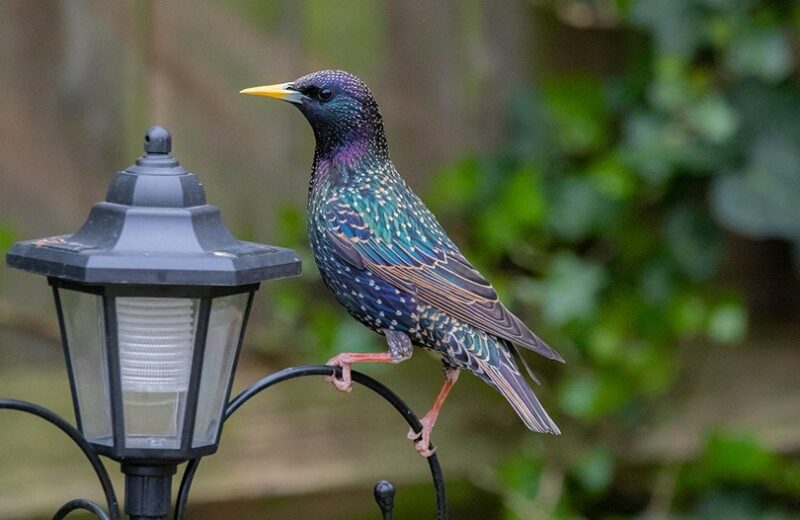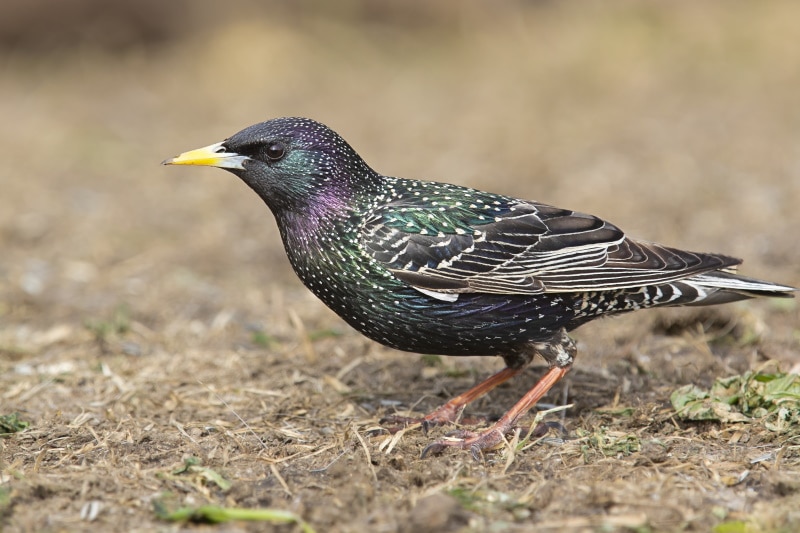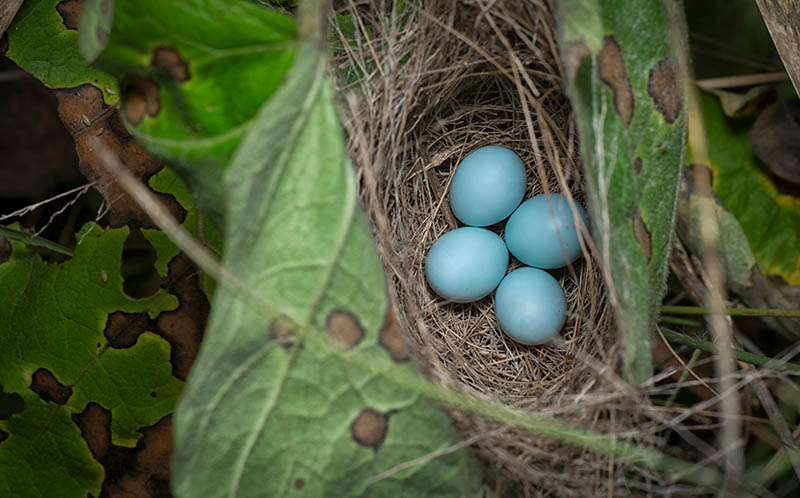How To Get Rid of Starlings: 16 Tips & Tricks
Last Updated on

Since it’s invasive and often aggressive, the starling has a bad habit of causing problems for homeowners. Their loud calls are incredibly annoying and disruptive, they make a mess out of home gardens, and, worst of all, starlings chase other birds away. While they might be somewhat attractive, if you have dozens of them in your yard, you probably want to get rid of the starlings any way you can.
It’s crucial to remove the bothersome birds humanely. However, that is somewhat of a challenge since starlings can be difficult to keep away and prevent from returning. The good news is we’ve got 16 tips and tricks to help you do exactly that below. Read on to discover how to keep starlings from making a mess out of your backyard.

The 16 Tips and Tricks on How to Get Rid of Starlings
1. Prune your Trees Often

Starlings need to feel safe and secure in your yard. They like to occupy trees in large groups, which makes pruning your trees and reducing branch density critical if you want to keep starlings away.
The fewer the branches, the more exposed starlings will be to predators, which they genuinely don’t like. Pruning is essential for decorative and fruit trees, which typically have denser branches. Cutting them back as much as possible is a simple, effective, and humane way to keep starlings at bay. Even better, some species of birds like trees with fewer branches and will gladly come to visit after they’re pruned.
- Effective
- Helps other birds
- Labor-intensive
- Needs to be done often
2. Change your Bird Feeder
Starlings are aggressive birds that take over a bird feeder and chase other birds away. If that’s happening in your yard, one thing you can do is purchase a starling-proof feeder. The specialized feeders typically combine standard feeders with an outer cage that keeps out larger birds and other pests like squirrels and chipmunks. When choosing a new feeder, look for one with a large cage diameter, as starlings have a habit of sticking their heads through the holes in the cage and getting to the food. With a wider cage, they won’t be able to reach the bird seed you put out, and other birds will be able to feed in peace.
- Works well
- Helps other birds
- Extra cost
- Keeps other large bird species away also.
3. Cover Flat Surfaces where Starlings Like to Sit
One habit that starlings have is to gather on flat surfaces like ledges, the tops of walls, and on wide fences. Taking away the opportunity to use the flat surfaces is critical if you want to keep starlings from gathering around your yard. You can use a few methods to do this, including installing an angled piece of sheet metal or a wooden plank on walls and ledges. You can also purchase “porcupine wires” at your local home-improvement store (although many homeowners find them rather ugly).

- Effective
- Takes away starlings’ favorite spot for socializing
- Takes time, effort, and money
- Can often look unattractive
4. Use Noise and Movement to Scare Starlings
Like many birds, starlings like peaceful, quiet, and safe surroundings, especially when they want to roost. That opens a door of opportunity for you to scare them away with loud noises and moving devices.
There are quite a few noisemaking devices on the market, including fake owls, laser lights, water spraying devices, and sound-emitting devices that send out calls that sound like the starling’s predators. Experts recommend using a combination of sound, movement, and lights to scare starlings away.
- Works well
- Makes a lot of noise, which could be a problem for neighbors
- Can be expensive
- Can scare other birds
5. Don’t Waste your Money on Ultrasonic Sound Systems
While many manufacturers say ultrasonic sound devices work great at keeping starlings away, here’s a critical fact you need to know; starlings can’t hear ultrasonic sounds. That makes these devices absolutely worthless if your goal is to get rid of starlings and a waste of your hard-earned money.

- Saves you money
- N/A
6. Cover your Fruit Trees
Two things starlings love are trees to roost in and fruit to munch on. If you have fruit trees, you might as well have a sign in your yard that says “Starlings Roost Here.” Cover your fruit trees with a plastic or nylon tree covers; the covers are available at your local garden or home improvement store. One challenge, though, is putting them on your trees.
You might need help, especially if your trees are tall. You should also cover any other tree(s) that starlings seem to like in your yard. Check the trees occasionally to ensure the intelligent birds don’t make holes in the cover and get inside. Once the starlings have moved on, you can remove the covers.
- Works moderately well
- Protects your trees and fruit
- Can get expensive
- Can be difficult to attach if you have larger trees
- Prevents other birds from roosting
- Keeps out helpful bees and insects
7. Get Rid of Old Starling Nests
Starlings return to the same breeding ground yearly, and other starlings will reuse a nest even if the original birds don’t reuse it. That makes it imperative you search for and remove their nests whenever you see them.
However, you cannot remove a nest if starlings are actively using it; starling nests are protected by federal law in the United States. However, removing a starling nest is legal as long as it’s empty and unused, but we recommend using gloves when removing it. Once you do, cover or seal the area where the starlings built the nest to ensure another pair doesn’t use it again.

- Very effective
- Finding nests can be difficult
- Might be illegal
8. Cover Small Holes and Cavities where Starlings like to Nest
Starlings are cavity nesters, which means they like to make their nests in small openings in trees, sheds, or anywhere around your home with a hole such as a vent. Amazingly, starlings can fit through a hole only 1.5 inches in diameter, so sealing even smaller holes is essential. Wire mesh is a good choice for most holes and crevices, but you can also use mosquito netting and other materials depending on the situation and the hole’s location.
- Vey effective
- Prevents other critters from entering your home
- Protects your home
- Takes time and energy
- Could cost a significant amount of money
9. Hang Plastic Strips in Front of a Barn or Shed Door
A barn or shed on your property is a location starlings love because it provides food, shelter, and a place to roost peacefully. Most of the time, they fly in and out through the front door, allowing you to deter them with an easy trick: clear plastic strips. You can hang them in the doorway in minutes. The strips allow you, your livestock, or your pets to see and enter, but starlings won’t because they can’t fly through the strips.

- Works very well for barns
- Easy to attach
- Relatively expensive
10. Make it Difficult for Starlings to Get Water
Like any living creature, starlings need water to survive. If you have standing water on your property, it acts as a natural attractant for starlings. Standing water can accumulate in gutters, troughs, rainwater collecting barrels, and, unfortunately, bird baths. Bird experts recommend covering all the water access points as best as you can, especially gutters. Yes, by covering (or emptying) bird baths, you prevent other birds from getting water, but once the starlings are gone, you can uncover them again.
- Moderately effective
- Simple process
- Takes water away from other birds
- Not easy to do in some situations
11. Don’t Put Out Food Starlings Eat
Many homeowners enjoy putting out bird feed to attract birds to their yard. The problem, however, is that starlings will eat all the food and chase away other birds trying to get a nibble. The simplest method to prevent them from coming to your yard is to stop putting out food starlings enjoy.
That includes suet, shelled peanuts, bread, sunflower hearts, small fruits, and mealworms. Instead, you can use peanuts and sunflowers in the shell, safflower seeds, and nyjer (thistle seeds). If you have a serious starling problem, you might consider removing all of your feeders for a while until you get the problem under control. Once the starlings have moved on, you can put your feeders back outside and allow other species to feed in peace.

- Works very well
- Foods attract other species
- Takes away foods that some other birds also enjoy
12. Don’t Wait to Start your Anti-Starling Crusade
There’s an old saying about starlings that goes, “One starling is one too many.” If you see a starling or two in your yard, you should immediately start using the methods we’ve talked about today to prevent more of them from coming. If you don’t, soon enough, you will have an entire flock of them making a mess, scaring away other birds, and eating all the food on your property.
- Excellent method to prevent starlings from gathering in the first place
- Some deterrents are time-consuming to install
13. Use Funnel Traps
This method won’t be as successful if you have a huge number of starlings in your yard. However, if you only have a few, you can use funnel traps to trap them and take them to an area far from your home. To do so, place one or two funnel traps in your yard and use some berries, peanuts, or cracked corn to attract starlings inside. Once they’ve been captured, place a cover over the trap and take the starlings a few miles from where you live to set them free.

- Moderately effective
- Humane trapping method doesn’t harm the bird
- Can trap other birds
- Expensive
- Need to travel to release the starlings
14. Upside Down Suet Feeders Work Well
Earlier, we talked about changing your bird feeder to a type that starlings can’t or won’t use. One of the best is an upside-down suet feeder. Starlings don’t like to feed when hanging upside-down but instead like to perch while they stuff their faces. Yes, in desperate situations, they will sometimes hang while they grab food, but for the most part, an upside-down suet feeder will prevent starlings from gathering.
- Works well
- Attracts other birds
- Easy to use
- Makes it harder for some other birds to eat
- Extra cost
15. Use a Bird-Shaped Kite
Depending on where you live, the size of your yard, and the amount of wind you receive, using a kite shaped like a bird of prey can be an excellent way to prevent starlings from gathering in your yard. These specialized kites look like birds of prey that starlings avoid. One caveat is that your yard must have constant wind to keep the kite flying.

- Moderately effective
- Can be fun!
- Won’t work without wind
- Not always possible in a densely populated community
- The kite and equipment could be costly
- Needs daily attention
16. Use a Sprinkler with Motion Detection
Although it might not keep starlings from making a nest around your home, a sprinkler system with motion detection can keep them from gathering in your yard and eating. This method is humane and has the extra benefit of keeping other critters off your lawn.
- Effective
- Keeps other critters away
- Won’t prevent starlings from roosting and nesting
- Scares away other birds
Bonus Trick. Use a Bird Repelling App
Not surprisingly, there are a few apps you can download to your smartphone created specifically to scare away several species of birds, including starlings. Most have smart controls, too, and are said to work well. Bird Repellent is one of the best, but there are several others.

- Effective
- Humane
- Free
- Easy to use
- Doesn’t always work
- Requires a smartphone

Conclusion
Starlings, unfortunately, are destructive birds that chase other birds away and make noise when they gather in large flocks. They also have a nasty habit of transmitting diseases, devouring fruits and vegetables, and contaminating bird feeders with their feces. The little birds have a sadistic habit of tossing eggs out of existing nests to use the nest for themselves.
In other words, they aren’t the type of bird you want to gather in your yard. All the starling eradication methods we’ve discussed today are humane and effective to a certain degree, but if one technique does not work for your yard, you can experiment with the others.
Featured Image Credit: TheOtherKev, Pixabay
Table of Contents
- The 16 Tips and Tricks on How to Get Rid of Starlings
- 1. Prune your Trees Often
- 2. Change your Bird Feeder
- 3. Cover Flat Surfaces where Starlings Like to Sit
- 4. Use Noise and Movement to Scare Starlings
- 5. Don’t Waste your Money on Ultrasonic Sound Systems
- 6. Cover your Fruit Trees
- 7. Get Rid of Old Starling Nests
- 8. Cover Small Holes and Cavities where Starlings like to Nest
- 9. Hang Plastic Strips in Front of a Barn or Shed Door
- 10. Make it Difficult for Starlings to Get Water
- 11. Don’t Put Out Food Starlings Eat
- 12. Don’t Wait to Start your Anti-Starling Crusade
- 13. Use Funnel Traps
- 14. Upside Down Suet Feeders Work Well
- 15. Use a Bird-Shaped Kite
- 16. Use a Sprinkler with Motion Detection
- Bonus Trick. Use a Bird Repelling App
- Conclusion
About the Author Greg Iacono
Greg Iacono is a self-taught writer and former chiropractor who, ironically, retired early due to back problems. He now spends his time writing scintillating content on a wide variety of subjects. Greg is also a well-known video script writer known for his ability to take a complex subject and make it accessible for the layperson.
Related Articles:
How to Collimate Binoculars: 9 Expert Tips
How to Clean a Refractor Telescope: Step-by-Step Guide
How to Clean a Telescope Eyepiece: Step-by-Step Guide
How to Clean a Rifle Scope: 8 Expert Tips
When Were Binoculars Invented? History, Today & Future
Can You Use Binoculars to Look At Stars? How to Choose the Right Pair
How to Choose Binoculars for Bird Watching: 10 Expert Tips
10 Types of Hummingbirds in Arkansas (With Pictures)
